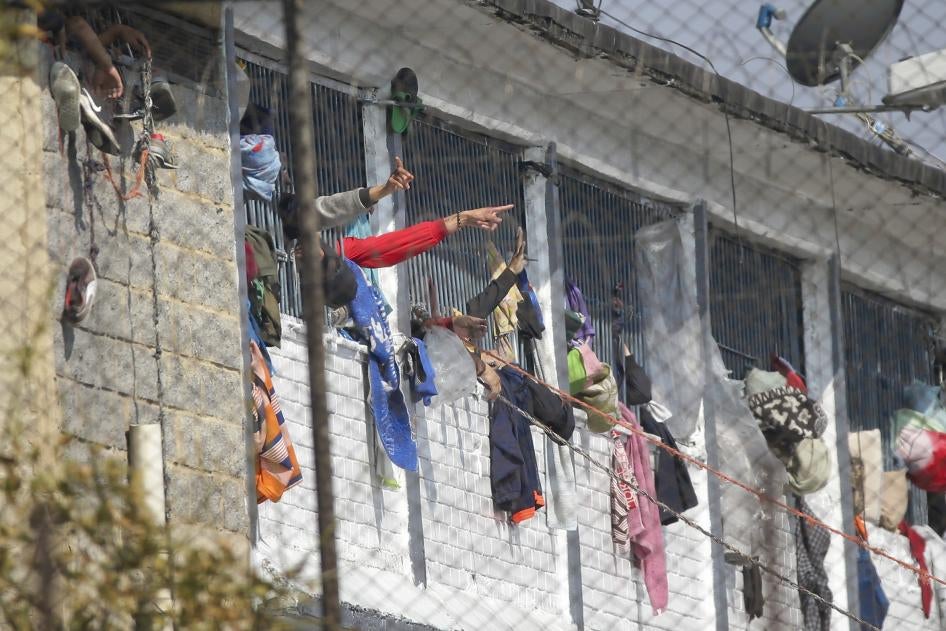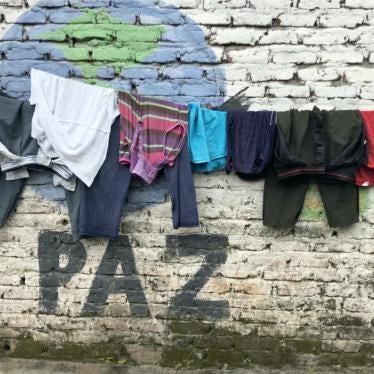(New York) – A new report by international forensic experts commissioned by Human Rights Watch points to the intentional killing of detainees during a prison riot in March 2020 in Colombia, Human Rights Watch said today.
On March 21, 24 prisoners died and 107 people were injured, including 76 detainees and 31 prison guards, as guards responded to a riot in La Modelo jail in Bogotá. The riot occurred in the context of several protests in prisons demanding adequate conditions to prevent the spread of Covid-19. The Independent Forensic Expert Group (IFEG) and the International Rehabilitation Council for Torture Victims (IRCT) analyzed the 24 post-mortem examination (autopsy) reports issued by Colombia’s National Institute for Legal Medicine and Forensic Science. They found that “Most of the gunshot wounds described in the autopsy reports are consistent with having been produced with the objective of killing.” The experts also said that “The autopsy reports do not record any signs of gunshot injuries carried out with the intention of solely injuring individuals instead of killing them.”
“This new report is based on official documentation pointing to the intentional killing of detainees, yet there is little sign of progress in the investigation into the 24 prison deaths in March,” said José Miguel Vivanco, Americas director at Human Rights Watch. “Colombian authorities have the obligation to carry out prompt, impartial, and thorough investigations and to hold anyone responsible for use of excessive and unjustified lethal force accountable.”
IFEG is an international body of 42 preeminent independent forensic specialists from 23 countries who are recognized global leaders in the medico-legal investigation of torture, ill-treatment, and unlawful killing. The IRCT is the world’s leading center of knowledge on the physical and psychological effects of torture and ill-treatment. It is a coalition of 158 rehabilitation centers in 74 countries. The report commissioned by Human Rights Watch was by Morris Tidball-Binz, Duarte Nuno Viera, and James Lin.
On March 21, then Justice Minister Margarita Cabello said the deaths and injuries occurred as prison guards prevented a “criminal plan to carry out a jailbreak.” On March 23, La Nueva Prensa, a Colombian news outlet, published an audio recording of what appears to be a meeting between Cabello and authorities from Colombia’s National Prison System Institute (Instituto Nacional Penitenciario y Carcelario, INPEC) after the riots. Cabello is heard saying that she “feels proud” and “is very thankful” to prison guards for avoiding the jailbreak.
In August, Congress appointed Cabello as the new Inspector General. The Inspector General’s Office, which carries out disciplinary investigations of government officials, is investigating the deaths in La Modelo. Cabello will take office in January, which raises serious concerns about her conflict of interest in ensuring that the La Modelo investigation is prompt, effective, and independent.
Safeguards are needed to ensure that when Cabello assumes her new role as Inspector General, the investigation into the deaths in La Modelo is independent, thorough, and capable of identifying whether those responsible for the deaths committed crimes, Human Rights Watch said.
The 24 autopsy reports reviewed by the experts did not include any photos, sketches, ballistics analyses, or information from investigations of the scene of the events. Human Rights Watch corroborated the authenticity of the reports independently.
Ten of the reports were unsigned, including two that were marked “draft.” However, official sources told the forensic experts and Human Rights Watch that no updates or revisions had been submitted as of November 9. The experts did not have access to or review any additional information, for example, any investigative or medical reports on any prisoners who may have been injured, but not killed.
The experts noted that some of the autopsies describe recent non-lethal injuries produced at or around the time of death, which were unrelated to the gunshot injuries. However, it was not possible to conclude whether any prisoners had been tortured or otherwise ill-treated from the available autopsy reports alone.
In August, Human Rights Watch met with Colombia’s attorney general, Francisco Barbosa, to discuss the deaths in La Modelo. Barbosa said that his office had not charged anyone in connection with these events at the time. He said that prosecutors were pursuing three separate investigations concerning the instigation of riots, the deaths and injuries, and whether prison guards used excessive force. As of November 13, charges still had not been brought in connection with the deaths and injuries. The Attorney General’s Office said that prosecutors had interviewed 300 of the more than 4,900 detainees who were witnesses to the events, rejecting the suggestion that the investigations had been “sloppy or slow.” The statement suggests that the Attorney General’s Office is expecting to interview nearly all detainees in La Modelo, which, according to government figures from January 2020, holds 4,976 people.
In April, Barbosa told the media that commanders of the National Liberation Army (ELN) guerrillas and groups that emerged from the demobilized Revolutionary Armed Forces of Colombia (FARC) had instigated the La Modelo riots. His office has yet to charge anyone in connection to these crimes.
The Inspector General’s Office has also made limited progress. On November 9, a high-level official told Human Rights Watch that the office was investigating the deaths and injuries but had yet to identify any prison guard who was allegedly responsible. One challenge of the investigation, the official said, is that on the day of the riots, guards did not keep a record of which weapon each officer was using.
International human rights law protects the rights to life and physical integrity and imposes a heightened duty of care on government for people in its custody. It also requires authorities to conduct prompt, impartial, and effective investigations into any deaths or serious injuries that occur in custody. International standards such as the UN Principles on the Use of Force and Firearms provide that firearms may be used only when strictly unavoidable in order to protect life. Law enforcement officials should not use firearms in their relations with detainees except in self-defense, in defense of others against the immediate threat of death or serious injury, or when strictly necessary to prevent the escape of someone who poses a grave threat to life and is resisting authority.
“It is one thing to prevent detainees from escaping, and another to engage in the unlawful killing of prisoners,” Vivanco said. “Colombian authorities have an obligation to ensure that an effective investigation determines which one happened in La Modelo.”
|
News Release
Colombia: New Evidence Prisoners Were Intentionally Shot
No Accountability for 24 Detainee Deaths in March
Your tax deductible gift can help stop human rights violations and save lives around the world.
Tags
Most Viewed
-
March 29, 2021
“Everything I Have to Do is Tied to a Man”

-
January 16, 2026
Iran: Growing Evidence of Countrywide Massacres

-
November 25, 2019
A Dirty Investment

-
December 7, 2011
"How Come You Allow Little Girls to Get Married?"

-
January 20, 2026
DR Congo: Civilians in South Kivu City at Serious Risk




